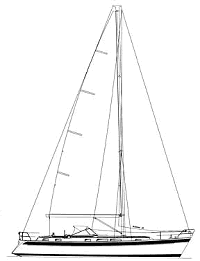HR 43
Bluewater cruiserr
Considering that this design will have to be your home for very extended periods let's begin with the layouts. There are two. You can have one double berth aft or a smaller double to starboard and a generous single berth to port. If you were serious about heading offshore I think the two aft berths would make more sense. For live-aboard and coastal cruising I'd go with the larger double berth and settee layout. You also have the option of Streisand chairs to starboard or a straight and far more sensible settee/berth.
I can't figure this out. What's with the small reefers on these new boats? I always work with the idea that you need the biggest reefer you can get and hopefully it will have both reefer and freezer sections. This 43-footer has a reefer that appears to be no bigger than the Swan or IMX reefers. Not that I don't like warm tuna fish sandwiches, but stowage room for cold food and frozen food is of paramount importance for distance cruising.
Note there is counter space on each side of the sink and counter space on each side of the stove. There isn't a lot of counter space, but then 43 feet is pushing the lower limit for a center cockpit boat, and considering that this design has an actual engine "room," this tight galley is no surprise.
The rest of the layout is fine. There are plenty of hanging lockers, two shower stalls and a nice, big chart table, as well as lots of small lockers. Lockers are expensive to build but very important to orderly stowage for cruising.
A serious consideration with any center cockpit boat designed for offshore is the lack of a lazarette. This can be accounted for if the forepeak is large, but in this case it is not and the lazarette is almost nonexistent. Now think of all the stuff you need to take with you on your yearlong trip. It can't all go below. Sure you could fill up one of the shower stalls, but that's not very elegant. Extra anchors, extra rode, crab pot, gasoline tanks for the outboard, the outboard, drogue, fenders, extra lines, buckets, hoses: All these things need specific, dedicated stowage spaces, and I'm just scratching the surface. I think you will be hard-pressed to find that stowage volume on this boat. Of course, in a boat show environment, stowage volume does not sell boats. Dried plants, macraméed whisky bottles and doilies sell boats.
I can remember going several rounds with John Neale years ago over what made for a good offshore cruising boat. He was attacking the Valiant 40 as being too "radical" with its separated keel and skeg-hung rudder. Today John sails an HR and I know he doesn't consider the V-40 radical any more. In fact, by V-40 standards, this new HR is radical. The D/L is 216 compared to the V-40's 260. The keel is shorter in chord length and the rudder has only half a skeg.
The 43 rig is the epitome of conservatism. The spreaders are in-line and there are fore and aft lower shrouds. The masthead location of the forestay will make this an easy rig to set up and a no-brainer once the initial tuning is finished. The SA/D is 17.35. This is a low number by today's standards, but it does have its benefits. I advise you, if you are considering offshore sailing, don't get carried away with big SA/D numbers. Big SA/D numbers can give you a very fast boat that sails very well in light air. But this same boat may require reefing at 18 knots apparent when the HR is comfortable with full sail at 22 knots apparent.
The HR boats are full of nice, thoughtful touches. These are well-thought-out boats that have few peers.

Comments